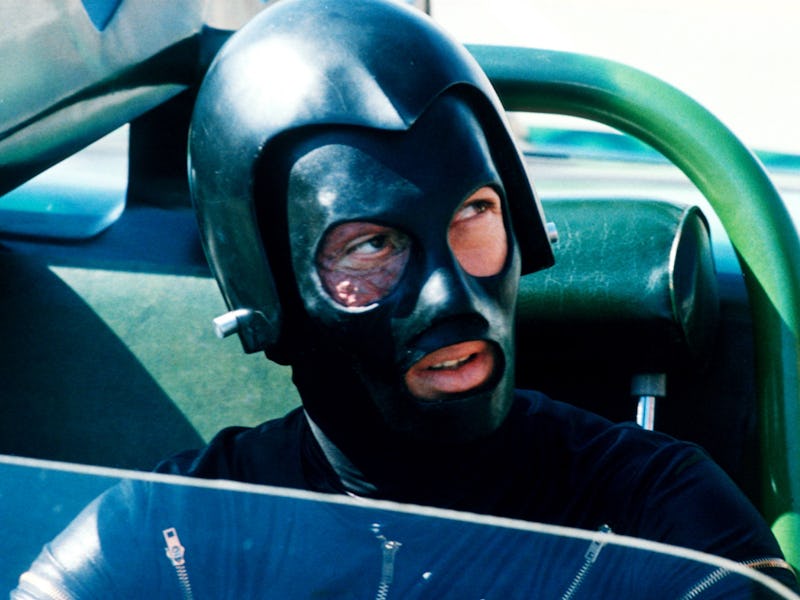Before The Running Man And The Hunger Games, There Was Death Race 2000
Across the town, the traffic is murder.

Stop me if you’ve heard this before: somewhere in the distant future, a totalitarian police state is formed in the wake of a country’s economic collapse and widespread civil unrest. The most popular television show is now state-sponsored, a cutthroat competition designed to keep an agitated population distracted and squash a potential uprising. Cornered and hunted, the contestants’ desperation to survive is distorted into the compulsion to kill. Elimination is by death only. Win, however, and you might not make it out with your humanity intact anyway.
Perhaps you thought of the 1987 Arnold Schwarzenegger action film The Running Man, about incarcerated criminals who must survive against professional hitmen in a game show if they are to win back their freedom. (Edgar Wright’s take on the 1982 Stephen King novel it’s based on will release this year). Maybe what sprung to mind instead is the formative millennial young-adult book — and Francis Lawrence-directed 2012 adaptation — The Hunger Games, in which children aged between 12 and 18 are forced to fight to the death in their dystopia’s cruel annual tournament. No? In the intersection of that Venn diagram, another King adaptation and Lawrence film, is this year’s horror movie The Long Walk. Its televised contest follows a 100 teenage boys who must walk without stopping until only one remains — those who fall behind thrice are shot dead.
But the course all these films traverse was first charted by the ludicrously silly, yet sharply satirical 1975 B-movie Death Race 2000. In Paul Bartel’s sci-fi actioner, costumed drivers with wrestling-style personas and custom-built themed cars compete in an annual Transcontinental Road Race, a spectacle engineered to excite the American public’s bloodlust (if only so the rush of cheering for others’ suffering might help them forget their own, following the “World Crash of ’79”.) Here, violence is not only accepted but celebrated as the “American way of life.” The all-American hero is Frankenstein (David Carradine), a leading champion who’s lost limbs and accumulated scars over the years, but is repeatedly sutured back together so he can strap himself in for yet another joyride.
What compounds the race’s cruelty is that it incentivizes acts of barbarism. The drivers earn points for running down pedestrians. The event’s terminology purposefully obscures its push for mass violence, reframing it as a sporting triumph — on the racecourse, “killing” is only referred to as “scoring.” Likewise, the prospect of toddlers and the elderly being worth the most points is horrific to viewers, but in a world so driven to be desensitized and rewarded for being inhumane, it can only become a morbid joke. “Euthanasia day at the geriatric hospital,” points out Frankenstein, delivering this all-timer of a phrase before swerving away from the elderly lined up outside to die and mowing through the hospital staff instead. “You know how fast those boy scouts move?” snipes another racer, Nero the Hero (Martin Kove), his only response to the suggestion that he should try mowing down a boy scout camp for points.
Far from sparking outrage, the pain and grief that ensues is commodified and packaged as entertainment to a public eager to lap up all the lurid details. In one scene, the widow of a newly run-over citizen is interviewed, her tragedy turned into television, her misery hand-waved away with the promise of material comforts. An offscreen audience watches, in the thrall of mindless consumption.
By contrast, the film itself doesn’t relish in, or linger on its kills, instead offering only brief flashes of spilled guts, squashed heads, and bloodied streets. The focus is on what the violence means. One of Frankenstein’s fangirls eagerly volunteers herself as a sacrifice so that he may gain more points. He runs her over without blinking.
Roberta Collins and Sylvester Stallone in Death Race 2000.
The film’s vision of a spectator sport-obsessed dystopia 25 years into the future is often high camp, but 50 years after its release, it appears unnervingly prescient of our world today. The public’s embrace of Nazism — contestant Matilda the Hun (Roberta Collins) is dubbed an “adorable Swastika Sweetheart” — isn’t far off from a modern U.S. President who claims the Nazis treated their prisoners “with love” or his government employee performing a “Roman salute.” Frankenstein running over doctors is viewed as proof of his “100% red-blooded American sense of humor,” an amusing bit of dialogue that calls to mind the more sobering “sin of empathy,” phrase coined by a Utah Deacon this year. Even more accurately, Death Race 2000 foresaw a president who appeared on reality TV, frequently disseminated misinformation, and was eager to start a new world war. Sound familiar?
In a plot point that would go on to recur in many of its successors, the film also includes a revolution orchestrated by a band of rebels (whose leader here is unsubtly named “Thomasina Paine.”) By the end, they’ve won, and Frankenstein, revealed to have been a stealth freedom fighter all along, is appointed the new president. He marries a rebel. He abolishes the races. All seems well. Then a simpering reporter (Don Steele) begins to annoy him.
How does Frankenstein resolve this conflict? He simply runs him over. And the crowd applauds. The racetrack becomes a depressing metaphor for a world going around in circles, ceaseless and unchanging.